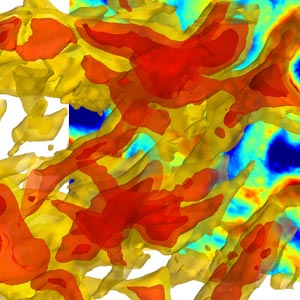KTH enters the petaflop era with new supercomputer

Fusion research simulated with supercomputers. (Photo: KTH PDC)
Sweden's KTH Royal Institute of Technology is due to begin using the fastest academic supercomputer of any university in Scandinavia. A Cray XC30 with 1,676 nodes and a memory of 104.7 terabytes will be installed at KTH’s PDC Center for High Performance Computing.
Access to the updated computational capacity will be through the Swedish National Infrastructure for Computing, SNIC.
Some of the uses for the computer will include fluid dynamics, climate modelling, plasma physics, neuroscience, materials science and molecular simulation.
The new system will operate at a peak performance of nearly 2 petaflops, which will make it six times faster than the university’s current supercomputer, Lindgren.
A single petaflop is equal to one thousand million (1015) floating-point operations per second. And like Lindgren, the new computer will be named after yet another renowned Swedish children’s author – in this case, Elsa Beskow.
The investment in KTH’s new supercomputer – including supporting systems, storage and running costs – has a budget of 170 million SEK divided over four years.
The funding comes primarily from SNIC, KTH and industry. After the installation of the system in October, there will be a period of preliminary testing, with the system expected to be in full production on January 1, 2015.
The supercomputer will be physically located at KTH’s supercomputer centre PDC.
Media Contact
All latest news from the category: Physics and Astronomy
This area deals with the fundamental laws and building blocks of nature and how they interact, the properties and the behavior of matter, and research into space and time and their structures.
innovations-report provides in-depth reports and articles on subjects such as astrophysics, laser technologies, nuclear, quantum, particle and solid-state physics, nanotechnologies, planetary research and findings (Mars, Venus) and developments related to the Hubble Telescope.
Newest articles

A universal framework for spatial biology
SpatialData is a freely accessible tool to unify and integrate data from different omics technologies accounting for spatial information, which can provide holistic insights into health and disease. Biological processes…

How complex biological processes arise
A $20 million grant from the U.S. National Science Foundation (NSF) will support the establishment and operation of the National Synthesis Center for Emergence in the Molecular and Cellular Sciences (NCEMS) at…

Airborne single-photon lidar system achieves high-resolution 3D imaging
Compact, low-power system opens doors for photon-efficient drone and satellite-based environmental monitoring and mapping. Researchers have developed a compact and lightweight single-photon airborne lidar system that can acquire high-resolution 3D…





















